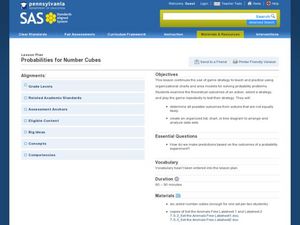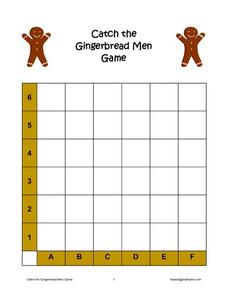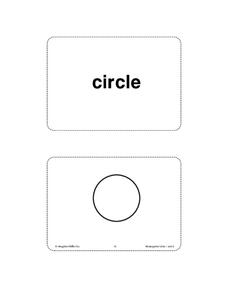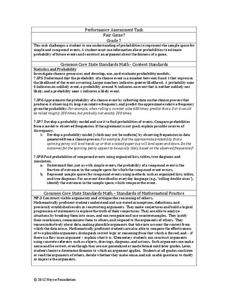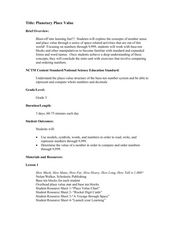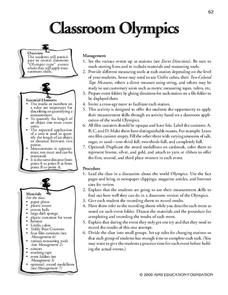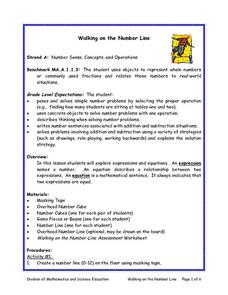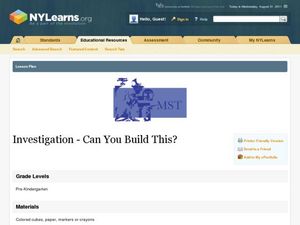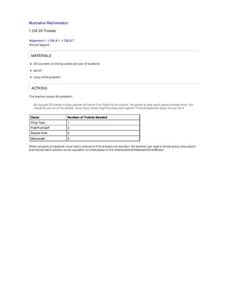K-5 Math Teaching Resources
Number Cube with Dots
Eliminate the noise of dice bouncing on desk tops with a number cube printable. After a few cuts, some folds, and a little glue, you'll have paper dice that can be used to engage your class in a number of...
K-5 Math Teaching Resources
Blank Number Cube
With this blank number cube, you have the flexibility to keep it blank or add markings to meet your lesson's needs.
K-5 Math Teaching Resources
Number Cube
Building a six-sided number cube has never been so easy. Just cut out the figure on the solid lines, fold on the dotted lines, connect the sides together using glue or tape, and there you have it!
Curated OER
Probabilities for Number Cubes
Young scholars explore the concept of probability. For this probability lesson, students roll a six-sided number cube and record the frequency of each outcome. Young scholars graph their data using a frequency chart and keep...
New York City Department of Education
How I Roll
There's a high likelihood for learner success in this set of probability problems and activities. From support activities that walk learners through joint and compound probabilities through the cumulative activity of planning to win...
Terry Kawas
Catch the Gingerbread Men Game
Catching men made of gingerbread motivates your young graphers to begin exploring the concept of finding a point in two-dimensional space. Learners practice locating each cookie by rolling two cubes (one with...
Curated OER
Count On Two More
Beginning counters will get great practice with this quick activity. In partners or individually, learners turn over a number card onto their "Count On Two More" game board (included). Then, they count out the correct number of units...
Houghton Mifflin Harcourt
Unit 3 Math Vocabulary Cards (Grade K)
Help young mathematicians develop understanding of math concepts with a set of 16 math vocabulary cards. Each sheet contains two cards; the top card has the vocabulary word printed in bold text. The bottom card has a picture...
K-5 Math Teaching Resources
Math Center Labels
From counters and calculators to pattern blocks and Unifix cubes, this collection of printable labels has exactly what you need to bring some organization to your elementary math class.
Curated OER
Board Game: Race to 100
Who can get to 100 first?! It may be in the hands of chance, but either way kids will have to practice counting and adding along the way. Partners take turns rolling two dice and moving their game pieces that many spaces until one pupils...
Noyce Foundation
Fair Game?
The game should be fair at all costs. The mini-assessment revolves around the ability to use probabilities to determine whether a game is fair. Individuals determine compound events to calculate simple probabilities and make...
Curated OER
Number Rods
Working in a math center or an "I finished early" work station, young mathematicians will match in sequence pre-set-up rods of unifix cubes to numbers on a number line. To help differentiate tens from ones, use different colors to...
Curated OER
Planetary Place Value
Third graders explore place value to the ten thousands place. This incredibly thorough, 24-page lesson has learners construct, order, and compare numbers to 9,999. This three-day lesson includes reteaching and extension activities...
National Council of Teachers of Mathematics
The Roll Out Fractions Game: Comparing Fractions
Reinforce the concept of comparing fractions with a hands-on, two-player game that calls for a visual model, score board, and dice. Players roll dice to acquire their given fraction, create the fraction using fraction tiles, then...
Curated OER
Kindergarten Numbers and Number Sense
Twelve math lessons take kindergartners through the process of number sense and counting. The skills range from counting to ten, filling out ten frames, indicating ordinal position of an object, and counting by fives and tens to one...
Curated OER
The Five Number Game
Learners explain what it means to square numbers. They explain what it means to cube numbers. Students define prime numbers using their own language. They are introduced to the problem by playing one game as a class.
AIMS Education Foundation
Classroom Olympics
As the Summer Olympics are approaching, incorporate Olympic-type games into the classroom. From straw javelin to cotton ball shot put, these games are sure to keep leaners engaged. The best part is that there is math involved! Pupils...
Curriculum Corner
Splashes of Spring Math Centers
Spring into math practice with a set of resources that taps into a variety of math practice. Skills include matching expressions to their definitions, a place value sorting activity, three multiplication and division games,...
Curriculum Corner
St. Patrick's Day Bump
Practice multiplying, and celebrate St. Patrick's Day simultaneously with a fun learning game. Here, players roll two six-faced number cubes and multiply the two face-up numbers to find the product. Then, they place a marker on...
Curated OER
Number Cube Activity
In this Algebra I worksheet, 9th graders roll a die to determine the value that will be substituted in order to determine the value of an algebraic expression. The one page worksheet contains eight problems. Answers cannot be...
Curated OER
Walking On The Number Line
Students investigate the concepts of expressions and equations while defining the similarities and differences. They explore the operations by using a number line and record answers while working with the teacher. Students play the game...
Curated OER
Paper Folding to Make Cubes
Examine patterns of figures composed of six-squares and predict which of the twenty presented could be folded to make a cube. They then fold large-scale patterns of these figures to confirm their hunches.
Curated OER
Investigation--Can You Build This?
Early learners explore shapes using colored blocks. They first get some hands-on time with the blocks and then look at beginning math concepts regarding spatial relationships. They work with a partner to build a 6-8 block tower...
Curated OER
20 Tickets
A great hands-on activity involving adding and subtracting, beginner mathematicians determine how many games can be played with 20 tickets. Instead of tickets, youngsters use 20 counters or linking cubes to represent the amount of...





